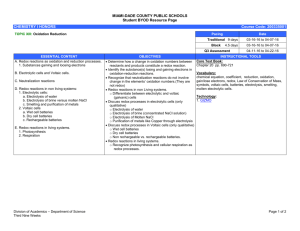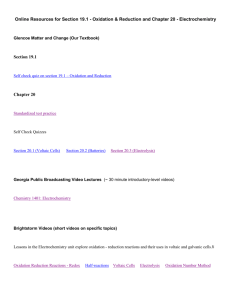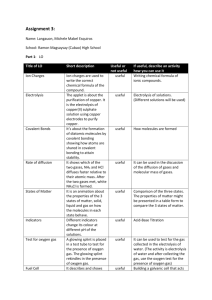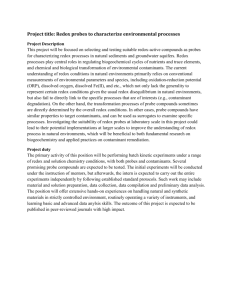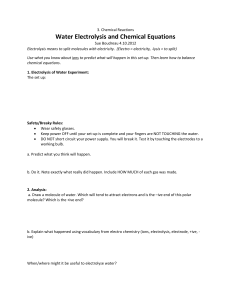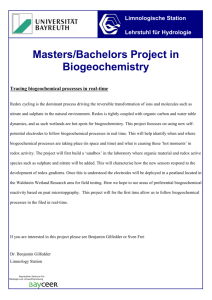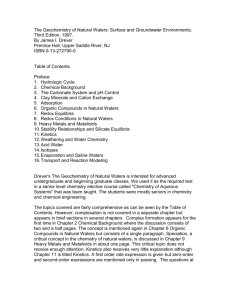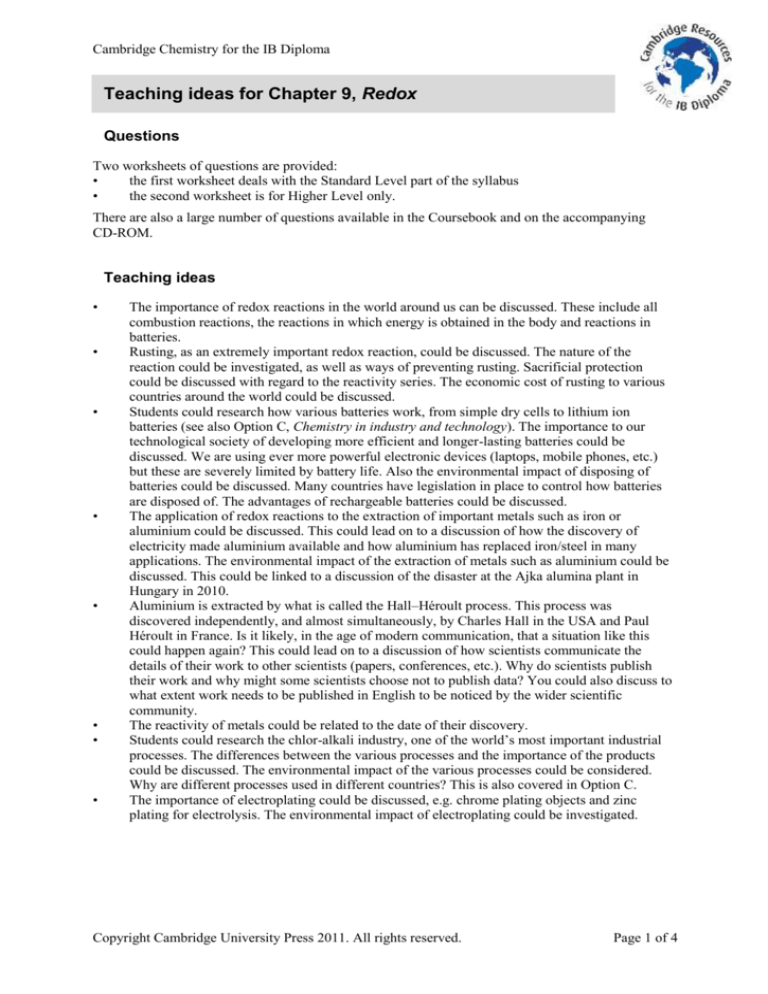
Cambridge Chemistry for the IB Diploma
Teaching ideas for Chapter 9, Redox
Questions
Two worksheets of questions are provided:
•
the first worksheet deals with the Standard Level part of the syllabus
•
the second worksheet is for Higher Level only.
There are also a large number of questions available in the Coursebook and on the accompanying
CD-ROM.
Teaching ideas
•
•
•
•
•
•
•
•
The importance of redox reactions in the world around us can be discussed. These include all
combustion reactions, the reactions in which energy is obtained in the body and reactions in
batteries.
Rusting, as an extremely important redox reaction, could be discussed. The nature of the
reaction could be investigated, as well as ways of preventing rusting. Sacrificial protection
could be discussed with regard to the reactivity series. The economic cost of rusting to various
countries around the world could be discussed.
Students could research how various batteries work, from simple dry cells to lithium ion
batteries (see also Option C, Chemistry in industry and technology). The importance to our
technological society of developing more efficient and longer-lasting batteries could be
discussed. We are using ever more powerful electronic devices (laptops, mobile phones, etc.)
but these are severely limited by battery life. Also the environmental impact of disposing of
batteries could be discussed. Many countries have legislation in place to control how batteries
are disposed of. The advantages of rechargeable batteries could be discussed.
The application of redox reactions to the extraction of important metals such as iron or
aluminium could be discussed. This could lead on to a discussion of how the discovery of
electricity made aluminium available and how aluminium has replaced iron/steel in many
applications. The environmental impact of the extraction of metals such as aluminium could be
discussed. This could be linked to a discussion of the disaster at the Ajka alumina plant in
Hungary in 2010.
Aluminium is extracted by what is called the Hall–Héroult process. This process was
discovered independently, and almost simultaneously, by Charles Hall in the USA and Paul
Héroult in France. Is it likely, in the age of modern communication, that a situation like this
could happen again? This could lead on to a discussion of how scientists communicate the
details of their work to other scientists (papers, conferences, etc.). Why do scientists publish
their work and why might some scientists choose not to publish data? You could also discuss to
what extent work needs to be published in English to be noticed by the wider scientific
community.
The reactivity of metals could be related to the date of their discovery.
Students could research the chlor-alkali industry, one of the world’s most important industrial
processes. The differences between the various processes and the importance of the products
could be discussed. The environmental impact of the various processes could be considered.
Why are different processes used in different countries? This is also covered in Option C.
The importance of electroplating could be discussed, e.g. chrome plating objects and zinc
plating for electrolysis. The environmental impact of electroplating could be investigated.
Copyright Cambridge University Press 2011. All rights reserved.
Page 1 of 4
Cambridge Chemistry for the IB Diploma
•
Electrolysis of water is one method that has been investigated for the commercial
production of hydrogen as a fuel. The process, however, is not very environmentally
friendly unless the electricity can be produced without the use of fossil fuels. The redox
reactions in hydrogen fuel cells could be investigated and the rise of hydrogen fuel cell vehicles
discussed. Many major automobile manufacturers are producing hydrogen-powered cars. The
advantages and disadvantages of these vehicles could be discussed.
Pratical activities
Safety
Extreme care must be exercised when carrying out any practical activities in the classroom and a risk
assessment should be conducted before carrying out the experiments.
Demonstrations
•
•
•
•
•
•
There are various demonstrations that can be carried out to demonstrate the idea of a redox
reaction. These range from spectacular examples involving combustion (the reaction between
magnesium/zinc and copper oxide or between zinc and sulfur) to test-tube reactions involving
colour changes such as the reaction between acidified dichromate(VI) solution and Fe2+(aq) or
I– ions, or the disproportionation reaction that occurs when copper sulfate solution reacts with
potassium iodide solution:
http://www.practicalchemistry.org/experiments/the-reaction-between-zinc-and-copperoxide,303,EX.html
http://www.practicalchemistry.org/experiments/advanced/redox-reactions/topic-index.html
http://www.practicalchemistry.org/experiments/intermediate/oxidation-and-reduction/topicindex.html
The idea of a reactivity series could be introduced by demonstrating reactions between metals
and salt solutions or reactions between halide ions and halogen solutions (see below).
The basis of voltaic cells can be demonstrated by starting with a simple displacement reaction
between a reactive metal and a salt solution, discussing the electron transfer involved, then
building the cell in which the same reaction occurs:
http://www.funsci.com/fun3_en/electro/electro.htm
http://www.nistepkscience.com/Chemistry/9Electriccell.pdf
Simple test-tube reactions can be used to illustrate how the electrode potential can be used to
predict the feasibility of a redox reaction. Reactions that could be used are those between
acidified dichromate(VI) solution and solutions containing chloride, bromide or iodide ions, or
displacement reactions between halide ions and halogen solutions.
Electrolysis can be demonstrated using molten lead bromide/zinc chloride or various aqueous
solutions. How gas is collected should be demonstrated. The relationship between the number
of electrons transferred and the volume of gas produced can be demonstrated using the
electrolysis of acidified water in a Hoffman voltameter:
http://www.practicalchemistry.org/experiments/intermediate/electrolysis/electrolysis-of-zincchloride,50,EX.html
The electrolysis of copper sulfate solution using different electrodes should be demonstrated:
http://www.practicalchemistry.org/experiments/intermediate/electrolysis/electrolysis-ofcopperii-sulfate-solution,108,EX.html
Copyright Cambridge University Press 2011. All rights reserved.
Page 2 of 4
Cambridge Chemistry for the IB Diploma
Student practicals
There are several practicals that can be carried out on this topic.
•
•
•
•
•
•
•
Students could put metals into a reactivity series using the reactions with acid (hydrochloric or
sulfuric) or displacement reactions using salt solutions. The reactivity of the halogens could be
investigated using displacement reactions between halogen solutions and solutions containing
halide ions:
http://www.practicalchemistry.org/experiments/displacement-reactions-between-metals-andtheir-salts,304,EX.html
http://www.lgschemistry.org.uk/PDF/C3.1_Displacement_of_metals.pdf
http://www.creative-chemistry.org.uk/alevel/module2/documents/N-ch2-05.pdf
Establishing a reactivity series for some non-metals:
http://www.practicalchemistry.org/experiments/displacement-series-for-nonmetals,259,EX.html
Students could carry out a redox titration. There are various suitable titrations:
–
for example KMnO4 with iron(II) ammonium sulfate (0.10 mol dm–3 iron(II) ammonium
sulfate and 0.020 mol dm–3 potassium manganate(VII) with 10 cm3 of 2 mol dm–3
sulfuric acid)
–
iodine with sodium thiosulfate (0.10 mol dm–3 iodine in potassium iodide solution and
0.10 mol dm–3 sodium thiosulfate, using starch indicator).
http://web1.uct.usm.maine.edu/~tracy/chy116sumfolder/chy116s2011labsfolder/RdxTi.html
http://faculty.ccri.edu/eterezakis/1100%20Exp%205,%20Iron%20Analysis%20by%20Redox%
20Titration%20_egt_.pdf
http://www.lahc.edu/classes/chemistry/arias/Exp%208%20-%20Redox.pdf
http://chem.lapeer.org/Chem2Docs/RedoxTitration.html
http://www.outreach.canterbury.ac.nz/chemistry/documents/salt_iodate.pdf
Students can construct voltaic cells using metal electrodes and appropriate solutions. A simple
salt bridge can be made by soaking a strip of filter paper in an ionic solution such as saturated
potassium chloride. A variation on this is to make cells using lemons or potatoes, for example,
as the electrolytes. A practical investigation can be carried out looking at a factor that affects
the voltage of a voltaic cell:
http://virtual.yosemite.cc.ca.us/danielm/102/data/VoltaicExp.htm
Electrolysis can be carried out fairly easily on aqueous solutions. Students could collect gases
or measure changes in mass of electrodes.
Electrolysis experiments can be found at:
http://www.practicalchemistry.org/experiments/intermediate/electrolysis/topic-index.html
http://aquarius.nasa.gov/pdfs/electrolysis.pdf
http://www.saskschools.ca/curr_content/chem30_05/6_redox/labs/electrolysis.htm
Students could electroplate various metallic objects, e.g. copper plate a key or a nail. The object
to be plated should be cleaned beforehand with steel wool (or with nitric acid). Detailed
procedures are given in:
http://www.hkbu.edu.hk/~micschem/emanual/Expt%2010-Electroplating-english.pdf
http://www.woodrow.org/teachers/ci/1986/exp30.html
http://www.wellesley.edu/Chemistry/Chem&Art/Topics/Metals/pdf_files/echemjewels02.pdf
http://www.chemtopics.com/unit13/plating.pdf
Common problems
•
•
Balancing oxidation/reduction half equations and redox equations is something that students
often find difficult and will require quite a bit of practice. Many examples for practising
balancing half equations can be found in any standard data book.
HL students also have difficulty with electrolysis of aqueous solutions and understanding the
connection between electrode potentials and the various products obtained.
Copyright Cambridge University Press 2011. All rights reserved.
Page 3 of 4
Cambridge Chemistry for the IB Diploma
ICT
There are many opportunities for using IT in this topic. Many of the excellent websites listed
below contain simulations or videos.
•
•
•
•
•
•
•
Redox demonstrations:
http://www.chem.umn.edu/services/lecturedemo/
http://www.chem.uiuc.edu/clcwebsite/demos.html
Oxidation number calculator for transition metal complexes:
http://winter.group.shef.ac.uk/chemputer/oxidation-number.html
Redox reactions:
http://www.chem.iastate.edu/group/Greenbowe/sections/projectfolder/animations/PbAgtransfer.
html
http://www.chem.iastate.edu/group/Greenbowe/sections/projectfolder/animations/ZnCutransfer.
html
Redox titration:
http://www.chem.iastate.edu/group/Greenbowe/sections/projectfolder/flashfiles/redoxNew/redo
x.html
Redox – electrochemical cells:
http://chemmac1.usc.edu/resources/105b/resources/electrochemistry/galvanic.php
http://chemmovies.unl.edu/ChemAnime/Electro.htm
http://www.mhhe.com/physsci/chemistry/essentialchemistry/flash/galvan5.swf
http://www.chem.iastate.edu/group/Greenbowe/sections/projectfolder/flashfiles/electroChem/v
olticCell.html
http://www.chem.iastate.edu/group/Greenbowe/sections/projectfolder/animations/SHECu.html
Database about electrode potentials:
http://www.rsc.org/Education/Teachers/Resources/Databook/data/databases/electrode.zip
Electrolysis:
http://www.chem.iastate.edu/group/Greenbowe/sections/projectfolder/flashfiles/electroChem/
electrolysis10.html
Theory of knowledge (TOK)
Are oxidation numbers are real?
Why have scientists developed a systematic way of naming compounds based on oxidation numbers?
Copyright Cambridge University Press 2011. All rights reserved.
Page 4 of 4


